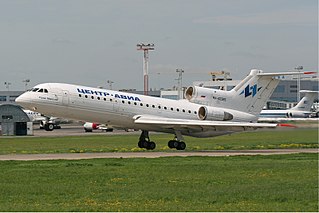
The Yakovlev Yak-42 is a 100/120-seat three-engined mid-range passenger jet. It was the first airliner produced in the Soviet Union to be powered by modern high-bypass turbofan engines.

The Yakovlev Yak-11 is a trainer aircraft used by the Soviet Air Force and other Soviet-influenced air forces from 1947 until 1962.

The Yakovlev UT-1 was a single-seater trainer aircraft used by the Soviet Air Force from 1937 until the late 1940s.

The Yakovlev Yak-24 is a Soviet twin-engine, tandem rotor, transport helicopter developed by Yakovlev in the 1950s. The Yak-24 saw limited use in the Soviet Air Force, and the exact number produced and duration of service are unknown due to inconsistencies in data.

The Yakovlev Yak-16 was a Soviet light transport that first flew in 1947. Prototypes were built in both passenger and military cargo versions, but neither was put into production as the Antonov An-2 was felt to be more versatile.
The Yakovlev Yak-44 was a proposed twin-turboprop Airborne Early Warning (AEW) aircraft, resembling the United States Navy's E-2 Hawkeye, intended for use with the Soviet Navy's Ulyanovsk class supercarriers. Along with the aircraft carrier it would have flown from, the Yak-44 was cancelled after the demise of the Soviet Union. A full-scale mockup with foldable wings was built.

The Yakovlev Yak-6 was a Soviet twin-engined utility aircraft, developed and built during World War II. It was used as a short-range light night bomber and a light transport.
The Yakovlev EG, also commonly known as the Yak-M11FR-1 and Sh (Shootka), was an experimental aircraft with coaxial rotors. The prototype was first flown by V.V. Tezavrovsky in December 1947.
The Yakovlev Yak-58 is a small, multi-role utility transport and business aircraft. The aircraft features a pusher engine and twin boom tail. It saw limited production in the late 1990s.
The Yakovlev Yak-5 was an experimental trainer aircraft designed by Yakovlev OKB in the Soviet Union, and first flown in 1944.

The Yakovlev Yak-8 was a Soviet utility aircraft developed during World War II. It was not accepted for production, but received the NATO reporting name "Crib" anyway.

The Yakovlev Yak-200 was a prototype Soviet multi-engine trainer built during the 1950s. A modified version was built as the Yak-210 for navigator training, but only one example of each was built before the program was cancelled in 1956.
The Yakovlev UT-3, initially known as the AIR-17 and then Ya-17, was a twin-engine low-wing monoplane aircraft designed by Alexander Sergeyevich Yakovlev for the Soviet Air Force (VVS).

The Yakovlev AIR-3 was a 1920s Soviet two-seat general aviation monoplane designed and built by Aleksandr Sergeyevich Yakovlev.
The Yakovlev AIR-6 was a Soviet light utility aircraft of the 1930s. It was a single-engined high-wing monoplane designed by Alexander Sergeyevich Yakovlev, with 128 being built.
The Bartini T-117, was a twin-engined cargo aircraft designed by Robert Ludvigovich Bartini in the USSR from 1944-1948.

TheYakovlev AIR-9 / AIR-9bis was a 2-seat sport aircraft designed and built in the USSR during the early 1930s.
The Yakovlev AIR-12 was a long-range sport aircraft designed and built in the Soviet Union during the late 1930s.
The Yakovlev AIR-11, also known as Yakovlev LT-1, was a 3-seat low-wing touring cabin monoplane designed by A.S. Yakovlev in the USSR, circa 1936.
The Ilyushin Il-26 was a late 1940s project for a strategic heavy bomber by the Ilyushin Design Bureau. There were a variety of alternative engines proposed for the Il-26, including the 3,400 kW (4,500 hp) Shvetsov ASh-2TK piston engine and 4,500 kW (6,000 hp) Yakovlev M-501 diesel engine. The specifications varied according to the number and type of engines proposed.










